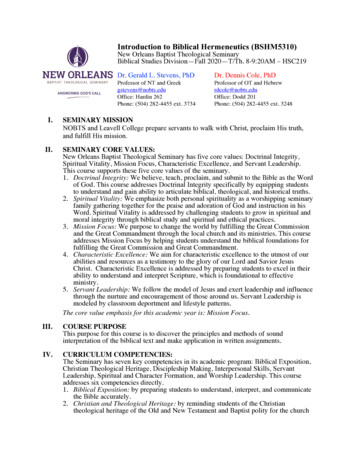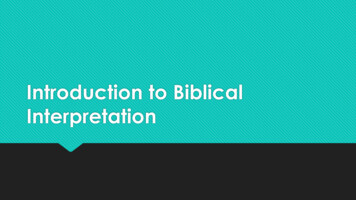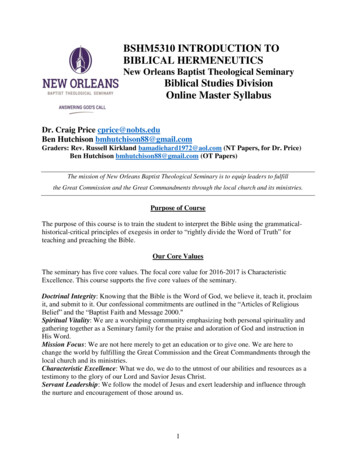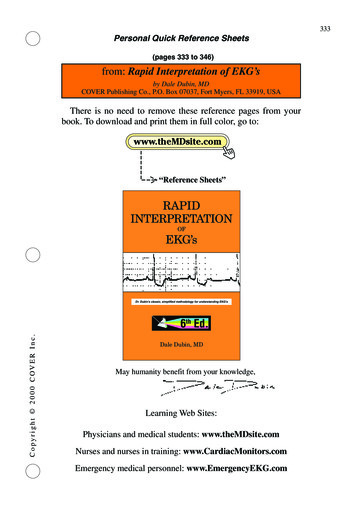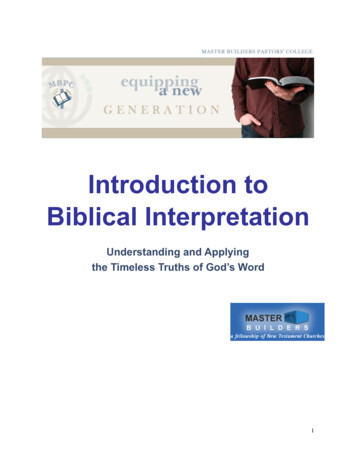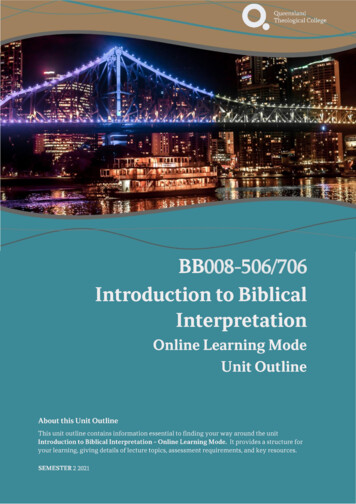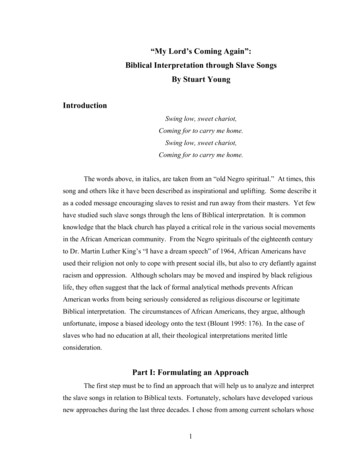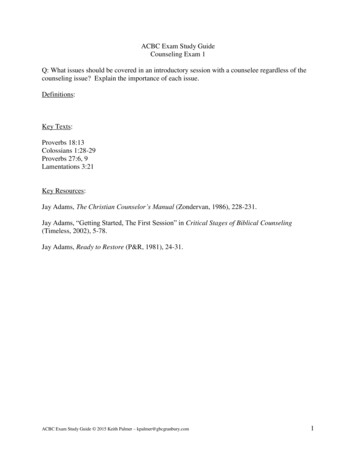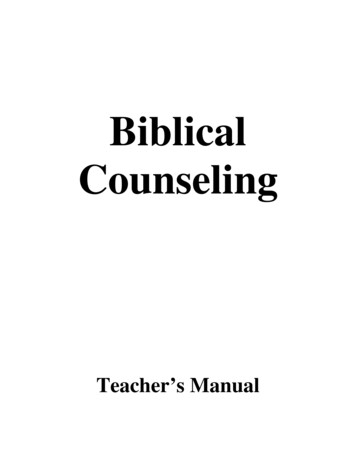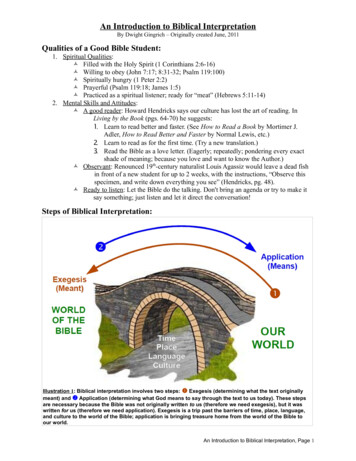
Transcription
An Introduction to Biblical InterpretationBy Dwight Gingrich – Originally created June, 2011Qualities of a Good Bible Student:1. Spiritual Qualities: Filled with the Holy Spirit (1 Corinthians 2:6-16) Willing to obey (John 7:17; 8:31-32; Psalm 119:100) Spiritually hungry (1 Peter 2:2) Prayerful (Psalm 119:18; James 1:5) Practiced as a spiritual listener; ready for “meat” (Hebrews 5:11-14)2. Mental Skills and Attitudes: A good reader: Howard Hendricks says our culture has lost the art of reading. InLiving by the Book (pgs. 64-70) he suggests:1. Learn to read better and faster. (See How to Read a Book by Mortimer J.Adler, How to Read Better and Faster by Normal Lewis, etc.)2. Learn to read as for the first time. (Try a new translation.)3. Read the Bible as a love letter. (Eagerly; repeatedly; pondering every exactshade of meaning; because you love and want to know the Author.) Observant: Renounced 19th-century naturalist Louis Agassiz would leave a dead fishin front of a new student for up to 2 weeks, with the instructions, “Observe thisspecimen, and write down everything you see” (Hendricks, pg. 48). Ready to listen: Let the Bible do the talking. Don't bring an agenda or try to make itsay something; just listen and let it direct the conversation!Steps of Biblical Interpretation:Illustration 1: Biblical interpretation involves two steps: Exegesis (determining what the text originallymeant) and Application (determining what God means to say through the text to us today). These stepsare necessary because the Bible was not originally written to us (therefore we need exegesis), but it waswritten for us (therefore we need application). Exegesis is a trip past the barriers of time, place, language,and culture to the world of the Bible; application is bringing treasure home from the world of the Bible toour world.An Introduction to Biblical Interpretation, Page 1
Exegesis: What the text meantI. Key question: “What was the inspired author's intended meaning for the original audience?”II. Definition: Exegesis is drawing the meaning “out of” the text. (It is the opposite of eisegesis,which is reading your own meaning “into” the text.) Exegesis is listening to the Bible,thinking God's thoughts after Him. It requires hard work and humility, and a willingness toput aside questions like “What's in it for me?” or “What does the Bible say about X(whatever topic I'm interested in at the moment)?” In exegesis we take a trip back to anothertime, place, language, and culture, and imagine we are original audience (e.g. the Israelites inJerusalem or the church in Rome), trying to understand what the author is writing to us.III. Why it is important: Without exegesis we are basing our lives on our own ideas rather thanon God's Word. By improper or hurried exegesis, cults misuse the Bible to support all sorts ofheretical positions. But “a text cannot mean what it never meant” (Fee and Stuart, How toRead the Bible for All its Worth, pg. 26). Since the Bible was not written to us (but for us), wemust determine what it was intended to mean to its original audience, then base all ourteaching and preaching on that.Our tendency is to skip exegesis and go straight to application—focusing on heartwarming devotional thoughts, topical teaching inspired by our own individual and culturalpet topics, and preaching of the parts of the Bible that appear easiest to understand, such asthe lists of commands. As a result, some of our devotional reflections, teaching, andpreaching sound surprisingly similar to something you could perhaps hear in a Jewishsynagogue or a Muslim mosque—full of encouraging thoughts, wise advice, and goodmorals, but lacking the uniquely life-giving essence of the gospel. Thus we use the Bible toreinforce what we already assume is true, rather than allowing the Spirit to use it as a swordto change our understandings, beliefs, and actions.IV. How to do it: Here are some elements of good biblical exegesis: A) Read the passage; B)Get the big picture—the literary form and historical context; C) Examine the literary contextD) Outline the flow of thought of the passage, identifying its main idea or purpose; E) Studythe details—key words and important themes; F) Compare your conclusions with the widerbiblical context; G) Consult commentaries; and H) Read it again!A. Read the Passage1. Read it again! And again—in several translations.2. Read the entire book in which the passage is found. With most books we wouldn'tthink of dropping into the middle somewhere and trying to understand it. Why do wedo that with the Bible?3. Observe as you read. Barrage the text with questions! Ask the 5 W's: who, what,where, when, why? Collect data for interpretation.B. Get the Big Picture1. Identify the Literary Form (Genre):a) Definition: Genre is the kind of literature used by the author. Modern genresinclude news article, owner's manual, novel, and textbook.b) Why it matters: When you identify the genre, you learn how the author intendedhis text to be used. If you use a novel as an owner's manual, you are in trouble! Ifyou use the book of Daniel as a biology textbook, you will be confused. If youuse the book of Joshua as a model for how Christians should treat their enemies.c) Literary genres in the Bible include:An Introduction to Biblical Interpretation, Page 2
Common Biblical Literary GenresGenreSome CharacteristicsExamplesLaw CodeGiven to the nation of Israel; must beinterpreted and applied in light ofChrist's fulfillment of the Law.Exodus 20-23; 25-40;Leviticus 1-27;Numbers 18-19;Deuteronomy 12-26.NarrativeStories and historical accounts; must beread as parts of God's “big story” of theentire Bible; examples must becompared with clear moral teachings.Much of Genesis-Ezra;the gospels; Acts. (Thegospels can be called aseparate genre.)PoetryIntended to be spoken or sung; full ofPsalms, Song ofemotional imagery; must consider who Solomon, much of Job,is “speaking” when interpreting.Proverbs, Ecclesiastes,the prophets.WisdomProverbs, riddles, admonitions,allegories, dialogues, and poems; mustconsider who is “speaking”; proverbsare not promises or commands.ProphecyAuthoritative preaching and prediction; Most of Isaiah-Malachi;given with a specific audience, time,Matthew 24 (andplace, and purpose; must read alongside parallels).historical books.Apocalyptic Dramatic and highly symbolic; full ofdreams, visions and revelations; must“stress the theological and note thepredictive with humility” (Osborne).Job, Proverbs,Ecclesiastes, parts ofPsalms.Revelation, parts ofDaniel, Zechariah andother prophets.ParableBrief story using illustrating a moral; an 2 Samuel 12:1-6; a thirdexpanded proverb or riddle; must note of Jesus' teaching in thehistorical and literary settings tofirst 3 gospels!determine intended meaning.EpistleLetter to an individual, a church, orchurches; full of reasoned argumentsand personal exhortations; includesprinciples and commands for Christians.Romans-Jude (writtenby Paul, James, Peter,John, and Jude; authoruncertain—Hebrews).2. Establish the Historical Context:a) Why it matters: History is His-Story. God sovereignly decided the places, times,and cultures in which He would reveal His written Word. We must study HisWord within the context of His Story in order to understand the Bible.b) Two levels of historical context:i . General: The geography, animals and plants, politics, economics, militarysituation, cultural practices, and religious customs of the time period. Thesewill assist you with general understanding and interpreting difficult passages.ii . Specific: The circumstances of the specific Bible book you are studying: itsdate, location, author, and audience. These will help you determine thehistorical purposes of the book and clarify problem passages.An Introduction to Biblical Interpretation, Page 3
c) Tools for discovering historical context:i . The Bible: Mine the book you are studying for specific historical data! Readthe whole Bible to learn to think like an ancient Jew.ii . Bible dictionaries and encyclopedias: these contain topical historical articlesand also introductions to each book of the Bible.iii . Commentaries: for book-specific historical information.iv . Bible background commentaries: for more detailed historical study.v . Biographical studies of Bible characters: Abraham, Moses, David, Paul, etc.vi . Bible maps and atlases: You can fit ancient Israel into Iowa nearly 8 times!C. Examine the Immediate Literary ContextIllustration 2: Context is king! A careful reading of the context of a passage will resolve mostimportant interpretive problems.1. Read as much of the surrounding text as possible.a) Begin with the confusing word or passage and work your way outward toward therest of the Bible, going at least as far as the whole book.b) See how the passage fits into the progress of thought of the whole book. Youcould:i . Read, scan, or listen to the entire book, if you have time.ii . Create a basic outline of the entire book, if you have even more time.iii . Consult an outline of the book provided in a study Bible, Bible dictionary, orcommentary, if you are short on time.An Introduction to Biblical Interpretation, Page 4
D. Outline the Progress of Thought within the Passage1. Analyze the structure of sentences, the basic units of thought:a) Look for the core idea of each sentence—the main verb (word of action orbeing), the subject (who or what does the acting or being), and the object(answers the questions “who/what?” or “for/to whom/what?”).b) Look for supporting words, phrases and clauses.c) Be especially aware of connectives: and, but, for, therefore, because, so that,then, until, although, while, where, etc.d) Example: The core of Romans 12:1 is “I urge you. to present your bodies a.sacrifice” (NASB). All the rest is support material that builds on this core idea,and a connective (“therefore”) that links the core idea to what came before.(Detailed breakdown: I urge [subject verb] you [answers “I urge who?”] topresent your bodies. a sacrifice [answers “I urge you to what?”].)2. Analyze how sentences fit together to form paragraphs, and how paragraphs fittogether to form larger sections. Common literary and logical structures include:a) cause and effect: Romans 1:21-31 is tied together by cause (mankind rejectsGod) and a series of effects (God “gave them over” to sins).b) comparison or contrast: Romans 8:1-17 is tied together by the theme ofcontrasting the flesh with the Spirit.c) repetition of concepts or words: Romans 7 is tied together by the word “law”;Romans 8:18-30 by the words “groan” and “glory”; Romans 12:1-15:13 by wordsrelated to “thinking” or “mind.”d) parallel items: Romans 16:1-16 is a series of greetings.e) imagery: Romans 17-24 is a sustained metaphor about olive branches.f) chiasmus (repetition in reverse order; can be on small scale or as large as a book):A “To those who by patience in well-doing seek for glory and honorand immortality, he will give eternal life;B but for those who are self-seeking and do not obey the truth,but obey unrighteousness, there will be wrath and fury.B' There will be tribulation and distress for every humanbeing who does evil, the Jew first and also the Greek,A but glory and honor and peace for everyone who does good, theJew first and also the Greek” (Romans 2:7-10, ESV).g) idea/event followed by its explanation: “Let every person be subject to thegoverning authorities” is explained in the following 7 verses (Romans 13:1,ESV).h) question and answer: “What shall we say then? Is there injustice on God’s part?By no means! For.” (beginning of a paragraph in Romans 9:14-18, ESV).i) dialogue: Paul carries on an imaginary dialogue with an opponent in Romans3:1-8.j) climax: The end of Romans 8 is a crescendo of excitement that is also a thematicclimax, the end of a large section of the book.k) hinge/turning point: “Therefore, having been justified by faith, we have.”summarizes the previous chapters and points forward (Romans 5:1).l) change of location or characters: In Matthew 24 Jesus has a series of threeparallel dialogues, each with different opponents, starting at verses 15, 23, and 34.An Introduction to Biblical Interpretation, Page 5
3. Give each paragraph a title or a summary sentence.4. Give each section a title or a summary sentence.5. Give your passage a title that summarizes its main idea or purpose.E. Study the Details1. Research key words.a) Key words include: repeated words, difficult words, theological terms, and wordstranslated differently in different translations.b) Steps for basic word studies:1. Compare multiple English translations.2. Use word study tools (see below) to find possible definitions.3. Choose which definition(s) fits best, based on: The context of the word in your verse. Other verses that use the same Greek or Hebrew word in a similar way.c) Some word study tools:i . Exhaustive concordances, such as Strong's Exhaustive Concordance of theBible. 1) Look up the English word, 2) find the listing for the verse you arestudying, 3) note the number of the Hebrew or Greek word beside your verse,and 4) look up that number in the dictionary in the back of the concordance.ii . Word study books, such as Vine's Complete Expository Dictionary, Vincent'sWord Studies, or, for a more up-to-date example, Mounce's CompleteExpository Dictionary.iii . Bible software or online programs. I use www.biblegateway.com as a generalconcordance and www.blueletterbible.org for word study. Both sites haveadvantages over book tools. For example, 1) they both allow you to search byphrase as well as by word, and 2) Blue Letter Bible allows you to do a“reverse search,” giving you a list of all the Bible verses in which a particularHebrew or Greek word is used. This way you can compare for yourself therange of different ways in which one word can be used, and find other versesin which the word is used similarly to how it is used in the verse you arestudying. This can be just as helpful as reading a dictionary definition.Another very helpful site is www.netbible.org.iv . Commentaries: A expository commentary on the book you are studying willusually discuss the meanings of important words, and will do so in context.d) Remember these facts about words and their meanings:i . Words generally have a range of possible meanings, not one all-encompassingmeaning.ii . Words normally have only one meaning in any particular literary context,unless a pun is intended.iii . The meanings of words change over time, so: Etymology (word origins and roots) is not a reliable guide to meaning.(E.g. “September” contains the prefix “sept/seven,” but is no longer theseventh month.) Modern words which come from an ancient word are not reliable clues tothe meanings of that ancient word. (E.g. “dynamite” comes from theGreek word “dunamis/power,” which is used in Romans 1:16 to describethe gospel, but the gospel is not destructively explosive like dynamite.)An Introduction to Biblical Interpretation, Page 6
iv . The meaning of a word is determined by 1) the range of possible meaningsfor which that word is used by people at that time, and 2) the specific context,which usually narrows those possible meanings down to one.v . It is hard to do word studies well; don't build a whole interpretation on themeaning of one difficult Hebrew or Greek word. Certainly don't build aninterpretation on the etymology or range of meanings of an English word inyour translation!2. Analyze important themes: Consider key theological themes or terms in your passageand compare with parallel passages, especially by the same author. (E.g. Galatiansshares many themes with Romans 1-8—Law, Spirit, flesh, righteousness throughfaith, children of Abraham—and helps us understand Romans.)F. Compare Your Conclusions with the Wider Biblical Literary Context1. This continues the process begun in point C) above (see Illustration 2), going beyondthe book to the rest of the Bible.2. Compare your passage with:a) Other books written by the author (e.g. read Galatians alongside Romans).b) Other books describing the life of the author (e.g. read Acts alongside Romans).c) Other books/passages of the same genre (e.g. read Peter's letters alongside Romans).d) The rest of the Old/New Testament (e.g. compare Romans with Jesus' teachings).e) The rest of the Bible (e.g. compare Paul's and Moses's statements about the Law).f) (To give wider historical context and greater clarity about literary forms and wordusage, you may read beyond the Bible. E.g., read the 1 st-century letter of Clementof Rome alongside Romans to meet a later leader of that church. However, neverlet extra-biblical literature lead you to conclusions that contradict Scripture!)G. Consult Commentaries1. Why read commentaries?a) In the words of William Mounce: “The best exegesis is begun with you and your Bible. Icannot emphasize this enough. Read the passage over and over. Pray that the Holy Spirit willshow you things you normally would miss. This is the best kind of Bible study, and certainly themost rewarding. However, you must not stop here. What if you are wrong?. This is wherecommentaries come in. It is a dangerous thing to say that you understood the passage correctlyand all the people who have studied the passage for years totally missed its meaning. Certainlythere are commentaries from which I as a pastor want to protect my congregation. But don't thinkof a commentary as a book. Think of it as a chance to listen to a person who probably hassubstantially more formal training and experience than you have. When you read a commentary, itwill provide checks and balances against your possible mistakes. If you read more than onecommentary, they provide checks and balances against each other as well. I am not saying that thecommentary is automatically right. But commentaries do more than provide checks and balances.They can answer questions that a reading of the text can never provide or ask questions that youmay never think of asking” (Greek for the Rest of Us: Mastering Bible Study Without MasteringBiblical Languages, Zondervan, 2003, pgs. 237-48)b) To say “I would never read any commentary” is like saying “I would never listento any preacher.” God calls us to maturity, which occurs as we practice discerninggood from evil (Hebrews 5:14). Read with care and prayer, and ask your spiritualleaders to help you discern truth.2. Which commentaries?a) The options can be overwhelming at first! Ask a Bible scholar friend for adviceabout good authors or publishers.An Introduction to Biblical Interpretation, Page 7
b) Unfortunately, there are few by conservative Mennonites, and even fewer that dodetailed exegetical work. Check with Mennonite publishers—or write one! c) Evangelical commentaries are sometimes described as devotional, pastoral,exegetical, or technical:i . Technical commentaries are designed for those with knowledge of Hebrewand Greek and will bore most of us to tears.ii . Devotional and pastoral commentaries are helpful for personal growth or forteaching outlines, illustrations, and applications.iii . Exegetical (or semi-technical) commentaries usually focus on exegesis ratherthan application. They are usually best for serious attempts by non-experts tolearn what the Bible meant.d) When choosing commentaries I consult, among other places:i . www.bestcommentaries.com This site summarizes commentary ratings frommany evangelical sources and leads you to individual reviews of a widevariety of commentaries. Good for learning what's available and popular.ii . eSet.pdf This is a morelimited list of semi-technical expository commentaries, compiled by a conservative evangelical. Healso helpfully introduces the main commentary series produced by evangelical publishers. I ownseveral from his list. None are perfect; all are very helpful! [Note: This site is nowunavailable. See www.dwightgingrich.com for updated commentary advice.]iii . www.amazon.com Reviews on this site often give a good sense of thetheological slant of a commentary and also indicate which may be tootechnical or not detailed enough for my needs.H. Read it again!1. Read it again and again.2. On your knees, asking for ability to understand and willingness to apply.3. Then trust and obey.4. Which will lead to ever-greater understanding and freedom, until you have moreinsight than all your teachers and understand more than the aged! (John 8:31-32;Psalm 119:97-104) Application: What the text meansI. Key Question: “What does God mean to say through this inspired text to us today?”II. Definition: Application is 1) taking what the passage meant and, based on that, 2) seeing whatit means today, then 3) believing and obeying. In application we take a trip home from theworld of the Bible to our world. We take what the biblical text originally meant and bring itforward to our time, place, language, and culture. Under the Holy Spirit's guidance, wedetermine in what way the text is relevant to us today and then let it authoritatively rule ourlives.III. Why it is important: Without application we are not “doers of the word”, but “merelyhearers who delude themselves” (James 1:22, NASB). No one is saved by mere knowledge;rather, increased knowledge means increased accountability, for “whoever knows the rightthing to do and fails to do it, for him it is sin” (James 4:17, ESV). In fact, without obedientapplication, we will not have ability to properly understand God's Word (John 8:31-32).A Bible student who does exegesis without application is like a boyfriend who becomes anexpert wedding planner but never proposes to his girlfriend; like a farmer who attends everyAn Introduction to Biblical Interpretation, Page 8
agricultural training conference around but never cares for his land; or like a pilot who, whilein flight, repeatedly rehearses landing procedures with his crew, but never begins landing theplane. Exegesis without application is pointless and dangerous!Our tendency is to avoid application to ourselves, but to apply Scripture instead to others.Sometimes we are so eager to apply to others that we do not do careful exegesis first,resulting in imbalanced or harsh application. Many of us know a lot of Bible facts, but do weunderstand how the parts of the Bible—such as Old Testament (OT) Law, the teachings ofJesus, and the letters to the New Testament (NT) churches—fit together into a message fromGod for us today? Over-eager or careless application can be as dangerous as none at all.IV. How to do it: Here are some elements of good biblical application. Please compare theseprinciples with God's Word, asking the Holy Spirit to help you discern truth and error!A. General Application Tips1. Pray and rely on the Holy Spirit: The Bible is not merely a textbook or a collection ofrules written to us that we can understand and apply by human wisdom. Rather, it isan inspired collection of many forms of literature addressed to many different people,yet written for us—all designed to reveal God, lead us to salvation, and equip us forgood works (2 Timothy 2:14-17). No set of principles will lead you infallibly tocorrect applications; only the Holy Spirit can do this, working in each specificbeliever and church in each specific circumstance.2. Remember all Scripture has some profitable application: 3 Timothy 3:16-173. Ask 12 simple questions to get started:a) Is there an example for me to follow?b) Is there a command to obey?c) Is there a sin to avoid?d) Is there a theological error to avoid?e) Is there a promise to claim?f) Is there a condition to meet?g) Is there a prayer to repeat?h) Is there a sin to confess?i) Is there a cause for praise or thanksgiving?j) Is there a passage to memorize?k) Is there a challenge to put into action?l) Is there something to share with others?(adapted and expanded from Howard Hendricks, Living By the Book, pgs. 304-307)B. Important Application Dos and Don'ts1. Do learn how to apply the Bible from the Bible itself:a) Observe how Jesus and NT authors applied the OT: For example:i . Jesus often affirmed or adapted OT teachings. E.g. Matthew 5:17-48; 12:1-8;15:1-9; 18:16; 19:1-9, 16-22; 22:34-40.ii . Paul often drew principles for action from OT theological truths or events:E.g. Romans 12:19; 14:10-13; 15:2-4; 1 Corinthians 6:15-18; 10:25-26; 11:710; 14:21-25; 2 Corinthians 9:8-11; Ephesians 5:31.iii . Paul explicitly affirmed or adapted OT commands at least 12 times: Acts 23:5;Romans 12:20; 13:8-10; 1 Corinthians 5:13; 9:8-10; 2 Corinthians 6:14—7:1;10:17; 13:1; Galatians 5:13-15; Ephesians 4:25-26; 6:1-3; 1 Timothy 5:17-18.iv . Paul said OT records were written for our instruction and example: Romans15:4; 1 Corinthians 10:6, 11; 2 Timothy 3:15-17; compare Hebrews 6:12; 12:1.An Introduction to Biblical Interpretation, Page 9
b) Observe how NT authors applied Jesus' example and teachings: E.g. Acts 20:35;Romans 15:3-8; Ephesians 4:32—5:2; Philippians 2:5; 1 Corinthians 11:23-27.c) Observe how NT authors claimed authority for their example and teachings: E.g. 1Corinthians 4:16; 7:10 (compare 7:12, 25); 11:1; Philippians 3:17; 1 Thessalonians1:6; 4:2; 2 Thessalonians 3:6-9; 1 Timothy 6:13-14; compare Hebrews 13:7.d) Also observe: how the OT interprets itself (e.g. all Psalm 78 in context of vs. 1-8);how prophetic passages are understood by NT authors; any other ways the Bibleinterprets and applies itself to the life of God's people.2. Don't commit common application errors. Here are ten:a) Don't apply every genre (kind of literature) the same way. For example:i . Historical narratives tell what was done, not necessarily what should be done.ii . Proverbs are not promises or commands.iii . Wisdom literature often includes speakers who portray ungodly perspectives.iv . Parables often have one main point; details may be irrelevant for application.b) Don't treat WWJD (What Would Jesus Do?) as a sufficient guide. Jesus is God; youare not. Perhaps you don't have authority to cleanse the temple? Or pray John 17:24?c) Don't treat historical accounts or examples as commands; let Scriptural commandsand principles guide our imitation. For example, don't assume we must imitate theapostles in every detail. Must we have “all things common” (Acts 2:44)?d) Don't quickly assume NT commands or examples are only relevant for 1 st -centuryculture. Might having “all things common” sometimes reduce greed and improveour witness?e) Don't argue from silence alone. The NT never mentions the use of songbooks, 4part harmony, or musical instruments in church; but that doesn't make themwrong. The NT never mentions gambling; but that doesn't make it right.f) Don't use commands given to one party in a relationship as teaching for the otherparty. “Servants, be subject to your masters [even] to the unjust” (1 Peter2:18, ESV) was not written to justify masters abusing slaves; “masters. stopyour threatening” (Ephesians 6:9, ESV) was not written to justify slavesoverthrowing abusive masters.g) Don't use one party's voluntary giving up of rights as justification for the otherparty's neglect of duty. “The Lord commanded that those who proclaim thegospel should get their living by the gospel” (1 Corinthians 9:14, ESV) is stilla command despite Paul's choice to preach voluntarily.h) Don't focus only on commands; apply the whole gospel message.i) Don't confuse indicatives with imperatives (indicatives statements of fact, suchas promises or things God says he has done; imperatives commands). “The fruitof the Spirit is love.” (Galatians 5:22-23) is not a command, but a fact, a promise!The command is “Walk by the Spirit” (vs. 16a), and it comes with the promise“and you will not gratify the desires of the flesh” (vs. 16b), because the Spirit willbear His fruit through you (vs. 22-23). That's a fact, not a command!j) Don't teach commands without rooting them in indicatives. The Bible never tellsus what to do without saying what God has already done, is doing, or will do.Never teach what should be without telling the good news about what already is,thanks to God through Jesus! The OT Law was not given until after God hadalready redeemed His people and promised them the land of Canaan; Paul'sAn Introduction to Biblical Interpretation, Page 10
letters almost always begin with indicatives (e.g. Ephesians 1-3) and end withimperatives (e.g. Ephesians 4-6). Teach first things first!C. Specific Guidelines for Applying NT Teachings:1. Consider that each teaching can be applied on two levels: 1) the level of the surfacecommand, where we treat the teaching as universal, as if it had been written directlyto us today, and 2) the level of the underlying principle, where we realize thesurface teaching is not for us to obey literally, but that it is rooted in a principle thatGod still expects us to obey today, in our own life contexts.How do we know on which level to apply a teaching? This is difficult;Conservative Anabaptists tend to apply most teachings at the level of the surfacecommand (sometimes forgetting underlying principles); liberal churches tend to applymost teachings only at the level of underlying principle (sometimes not even lettingthe principles control their behavior). But the answer is not as simple as applying allteachings on both levels: 1) Some teachings are clearly not meant to be literallyobeyed by us today; 2) Other teachings are uncertain enough that when we insistpeople must obey at the level of the surface command, we can needlessly divideChrist's Church; 3) Some life situations are given no surface command in Scripture,so we must use existing teachings to discover principles that apply in our situations.Here are some indications others have found helpful:On Which Level Should We Apply a NT Teaching?It is more likely it should be applied at It is more likely it should be applied atthe level of the surface command if.the level
An Introduction to Biblical Interpretation, Page 4 Illustration 2: Context is king! A careful reading of the context of a passage will resolve most important interpretive problems. D.Outline the Progress of Thought within the Passage 1. Analyz

